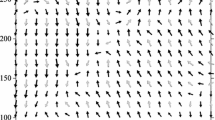Abstract
Complex-valued random fields represent a natural extension of real-valued random fields and can be useful for modeling vectorial data in two dimensions (i.e., a wind field). In such a case, some theoretical issues arise concerning generating and fitting complex covariance functions to be used for prediction purposes. In this paper, some general aspects and properties of complex-valued random fields are summarized and a procedure to fit complex stationary covariance functions is proposed. A case study for analyzing wind speed data is presented.










Similar content being viewed by others
References
Apanasovich TV, Genton MG (2010) Cross-covariance functions for multivariate random fields based on latent dimensions. Biometrika 97:15–30
Bochner S (1933) Monotone Funktionen Stieltjessche Integrale und Harmonische Analyse. Math Ann 108:378–410
Chilés JP, Delfiner P (1999) Geostatistics. Wiley, New York
Dagan G (1985) A note on the higher-order corrections of the head covariances in steady aquifer flow. Water Resour Res 21(4):573–578
De Iaco S, Palma M, Posa D (2003) Covariance functions and models for complex-valued random fields. Stoch Environ Res Risk Assess 17:145–156
De Iaco S, Myers DE, Palma M, Posa D (2010) FORTRAN programs for space-time multivariate modeling and prediction. Comput Geosci 36(5):636–646
De Iaco S, Maggio S, Palma M, Posa D (2012a) Towards an automatic procedure for modeling multivariate space-time data. Comput Geosci 41(4):1–11
De Iaco S, Maggio S, Palma M, Posa D (2012b) Advances in spatio-temporal modeling and prediction for environmental risk assessment. In: Haryanto B (ed) Air pollution—a comprehensive perspective, pp 365–390. doi:10.5772/51227
De Iaco S, Myers DE, Palma M, Posa D (2013) Using simultaneous diagonalization to identify a space-time linear coregionalization. Math Geosci 45(1):69–86
Du J, Ma C (2013) Vector random fields with compactly supported covariance matrix functions. J Stat Plan Inference 143:457–467
Gaspari G, Cohn SE (1999) Construction of correlation functions in two and three dimensions. Q J R Meteorol Soc 125:723–757
Goovaerts P (1997) Geostatistics for natural resources evaluation. Oxford University Press, New York
Grzebyk M, Wackernagel H (1994) Multivariate analysis and spatial/temporal scales: real and complex models. In: Proceedings of XVIIth international biometrics conference, Hamilton, Ontario, Canada, vol 1, pp 19–33
Journel AG, Huijbregts CJ (1981) Mining geostatistics. Academic Press, London
Lajaunie C, Béjaoui R (1991) Sur le krigeage des functions complexes. Note N-23/91/G, Centre de Geostatistique, Ecole des Mines de Paris, Fontainebleau
Li B, Zhang H (2011) An approach to modeling asymmetric multivariate spatial covariance structures. J Multivar Anal 102:1445–1453
Li B, Genton MG, Sherman M (2008) Testing the covariance structure of multivariate random fields. Biometrika 95(4):813–829
Ma C (2011) Covariance matrices for second-order vector random fields in space and time. IEEE Trans Signal Process 59(5):2160–2168
Majumdar A, Gelfand AE (2007) Multivariate spatial modeling using convolved covariance functions. Math Geol 39:225–245
Monestiez P, Petrenko A, Leredde Y, Ongari B (2002) Geostatistical analysis of three dimensional current patterns in coastal oceanography: application to the gulf of Lions (NW Mediterranean Sea). In: Sanchez-Vila H et al (eds) GeoEnv IV. Kluwer Academic, Netherlands, pp 367–378
Ver Hoef JM, Barry RP (1998) Constructing and fitting models for cokriging and multivariable spatial prediction. J Stat Plan Inference 69:275–294
Wackernagel H (2003) Multivariate geostatistics—an introduction with applications, 3rd edn. Springer, Berlin
Yaglom AM (1986) Correlation theory of stationary and related random functions, vols I, II. Springer, Berlin
Acknowledgements
The authors are grateful to Dr. Raimon Tolosana for his precious comments, the anonymous referees and the editor for their useful suggestions, which contributed to improvements in the paper.
Author information
Authors and Affiliations
Corresponding author
Rights and permissions
About this article
Cite this article
De Iaco, S., Posa, D. & Palma, M. Complex-Valued Random Fields for Vectorial Data: Estimating and Modeling Aspects. Math Geosci 45, 557–573 (2013). https://doi.org/10.1007/s11004-013-9468-z
Received:
Accepted:
Published:
Issue Date:
DOI: https://doi.org/10.1007/s11004-013-9468-z



